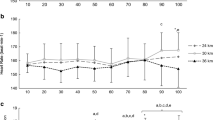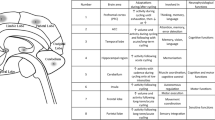Abstract
Purpose
Time-trial require cyclists to have an acute control on their sensory cues to regulate their pacing strategies. Pacing an effort accurately requires an individual to process sensory signals with efficacy, a factor that can be characterized by a high neural efficiency. This study aimed to investigate the effect of a cycling time-trial on neural efficiency in comparison to a low intensity endurance exercise, the latter supposedly not requiring high sensory control.
Methods
On two separate days, 13 competitive cyclists performed a session comprising of two 10 min treadmill tests, performed at different intensity zones from 1 to 5 on the rating subjective exercise intensity scale. The tests were performed before and after both a time-trial and endurance cycling exercise. Electroencephalography activity was measured during each intensity zones of the treadmill exercises. Neural efficiency was then calculated for each intensity block using the α/β electroencephalography activity ratio.
Results
The neural efficiency averaged on the 5 IZ decreased following the time-trial in the motor cortex (− 13 ± 8%) and prefrontal cortex (− 10 ± 12%), but not after the endurance exercise.
Conclusion
To conclude, the time-trial impaired the neural efficiency and increasing the RPE of the cyclists in the severe intensity zone.









Similar content being viewed by others
Availability of data and materials
All data and materials are available.
Abbreviations
- MC:
-
Motor cortex
- PC:
-
Parietal cortex
- PFC:
-
Prefrontal cortex
- RSEI:
-
Rate of subjective exercise intensity
- RPE:
-
Rate of perceived exertion
- IZ:
-
Intensity zones
- RPEIZblock :
-
RPE measured during a block of the treadmill test at different IZ of the RSEI scale (1–5)
- α/β IZblock :
-
Alpha/beta ratio measured during a block of the treadmill test at different IZ of the RSEI scale (1–5)
- α/β IZMean :
-
Averaged of the 5 α/βIZblock
- END:
-
Endurance
- TT:
-
Time-trial
References
Baron B, Grappe F, Groslambert A (2018) The global model of pacing process for long and ultra-long distance. Psychol 09:2837–2850. https://doi.org/10.4236/psych.2018.914163
Bigliassi M (2021) Neural basis of attentional focus during endurance exercise. Int Rev Sport Exerc Psychol 14:74–101. https://doi.org/10.1080/1750984X.2020.1762240
Bouillod A, Pinot J, Soenen F et al (2017) Dependence of the nature of the pedaling activity on maximal aerobic power in cycling. Int J Sports Physiol Perform 12:44–49. https://doi.org/10.1123/ijspp.2015-0489
Brümmer V, Schneider S, Abel T et al (2011) Brain cortical activity is influenced by exercise mode and intensity. Med Sci Sports Exerc 43:1863–1872. https://doi.org/10.1249/MSS.0b013e3182172a6f
Chaumon M, Bishop DVM, Busch N (2015) A practical guide to the selection of independent components of the electroencephalogram for artifact correction. J Neurosci Methods 250:47–63. https://doi.org/10.1016/j.jneumeth.2015.02.025
Cheron G, Petit G, Cheron J et al (2016) Brain oscillations in sport: toward EEG biomarkers of performance. Front Psychol 7:246. https://doi.org/10.3389/fpsyg.2016.00246
Ekkekakis P, Parfitt G, Petruzzello SJ (2011) The pleasure and displeasure people feel when they exercise at different intensities: decennial update and progress towards a tripartite rationale for exercise intensity prescription. Sports Med 41:641–671. https://doi.org/10.2165/11590680-000000000-00000
Filho E, Dobersek U, Husselman T-A (2021) The role of neural efficiency, transient hypofrontality and neural proficiency in optimal performance in self-paced sports: a meta-analytic review. Exp Brain Res 239:1381–1393. https://doi.org/10.1007/s00221-021-06078-9
Filipas L, Gallo G, Pollastri L, La Torre A (2019) Mental fatigue impairs time trial performance in sub-elite under 23 cyclists. PLoS ONE 14:e0218405. https://doi.org/10.1371/journal.pone.0218405
Fontes EB, Okano AH, De Guio F et al (2015) Brain activity and perceived exertion during cycling exercise: an fMRI study. Br J Sports Med 49:556–560. https://doi.org/10.1136/bjsports-2012-091924
Franco-Alvarenga PE, Brietzke C, Canestri R et al (2019) Caffeine improved cycling trial performance in mentally fatigued cyclists, regardless of alterations in prefrontal cortex activation. Physiol Behav 204:41–48. https://doi.org/10.1016/j.physbeh.2019.02.009
Grappe F (2005) Utilisation de la perception de l’effort comme outil d’estimation de l’intensité de l’exercice. In: Cyclisme et Optimisation de la Performance. De Boeck, Paris, pp 35–84
Grappe F (2009) Cyclisme et optimisation de la performance: Science et méthodologie de l’entraînement. De Boeck Supérieur
Grappe F (2018) Utilisation de la perception de l’effort comme outil d’estimation de l’intensité de l’exercice. In: Cyclisme et Optimisation de la Performance. De Boeck, Paris, pp 41–90
Greenhouse-Tucknott A, Butterworth JB, Wrightson JG et al (2022) Effect of the subjective intensity of fatigue and interoception on perceptual regulation and performance during sustained physical activity. PLoS ONE 17:e0262303. https://doi.org/10.1371/journal.pone.0262303
Haase L, Stewart JL, Youssef B et al (2016) When the brain does not adequately feel the body: links between low resilience and interoception. Biol Psychol 113:37–45. https://doi.org/10.1016/j.biopsycho.2015.11.004
Lepers R, Millet GY, Maffiuletti NA (2001) Effect of cycling cadence on contractile and neural properties of knee extensors. Med Sci Sports Exerc 33:1882–1888. https://doi.org/10.1097/00005768-200111000-00013
Lepers R, Maffiuletti NA, Rochette L et al (2002) Neuromuscular fatigue during a long-duration cycling exercise. J Appl Physiol 92:1487–1493. https://doi.org/10.1152/japplphysiol.00880.2001
Ludyga S, Gronwald T, Hottenrott K (2016) The athlete’s brain: cross-sectional evidence for neural efficiency during cycling exercise. Neural Plast 2016:4583674. https://doi.org/10.1155/2016/4583674
Mateo-March M, Valenzuela PL, Muriel X et al (2021) The record power profile of male professional cyclists: fatigue matters. Int J Sports Physiol Perform 7:1
Meeusen R, Van Cutsem J, Roelands B (2020) Endurance exercise-induced and mental fatigue and the brain. Exp Physiol. https://doi.org/10.1113/EP088186
Muriel X, Valenzuela PL, Mateo-March M et al (2022) Physical demands and performance indicators in male professional cyclists during a grand tour: WorldTour versus ProTeam category. Int J Sports Physiol Perform 17:22–30. https://doi.org/10.1123/ijspp.2021-0082
Noakes TD (2012) Fatigue is a brain-derived emotion that regulates the exercise behavior to ensure the protection of whole body homeostasis. Front Physio. https://doi.org/10.3389/fphys.2012.00082
Noble BJ, Borg GAV, Jacobs I et al (1983) A category-ratio perceived exertion scale: relationship to blood and muscle lactates and heart rate. Med Sci Sports Exer 15:523–528. https://doi.org/10.1249/00005768-198315060-00015
Ouvrard T, Groslambert A, Grappe F (2019) The influence of pleasure and attentional focus on performance and pacing strategies in elite individual time trials. Int J Sports Physiol Perf 14:451–457. https://doi.org/10.1123/ijspp.2017-0773
Pageaux B (2016) Perception of effort in exercise science: definition, measurement and perspectives. Eur J Sport Sci 16:885–894. https://doi.org/10.1080/17461391.2016.1188992
Pires FO, Silva-Júnior FL, Brietzke C et al (2018) Mental fatigue alters cortical activation and psychological responses, impairing performance in a distance-based cycling trial. Front Physiol 9:227. https://doi.org/10.3389/fphys.2018.00227
Robertson CV, Marino FE (2015) Prefrontal and motor cortex EEG responses and their relationship to ventilatory thresholds during exhaustive incremental exercise. Eur J Appl Physiol 115:1939–1948. https://doi.org/10.1007/s00421-015-3177-x
Russell S, Jenkins D, Smith M et al (2019) The application of mental fatigue research to elite team sport performance: new perspectives. J Sci Med Sport 22:723–728. https://doi.org/10.1016/j.jsams.2018.12.008
Scholler V (2022) Influence de l’efficience neuronale et des mécanismes perceptifs sur les sensations perçues par le cycliste pendant l’effort. Université de Franche-Comte
Scholler V, Groslambert A, Grosprêtre S, Grappe F (2021) Neural efficiency and ability to produce accurate efforts in different perceived intensity zones. Appl Psychophysiol Biofeedback 46:335–345. https://doi.org/10.1007/s10484-021-09517-z
Sharbrough F, Chatrian GE, Lesser R (1991) American electroencephalographic society guidelines for standard electrode position nomenclature. J Clin Neurophysiol 8:200–202. https://doi.org/10.1097/00004691-199104000-00007
Simmons AN, Fitzpatrick S, Strigo IA et al (2012) Altered insula activation in anticipation of changing emotional states: neural mechanisms underlying cognitive flexibility in special operations forces personnel. Cogn Neurosci Neuropsychol 23:234–239
St Clair Gibson A, Lambert EV, Rauch LHG et al (2006) The role of information processing between the brain and peripheral physiological systems in pacing and perception of effort. Sports Med 36:705–722. https://doi.org/10.2165/00007256-200636080-00006
Van Cutsem J, Marcora S, De Pauw K et al (2017) The effects of mental fatigue on physical performance: a systematic review. Sports Med 21:1
Williams NS, McArthur GM, de Wit B et al (2020) A validation of Emotiv EPOC Flex saline for EEG and ERP research. PeerJ 8:e9713. https://doi.org/10.7717/peerj.9713
Funding
The authors did not receive any funding for this work.
Author information
Authors and Affiliations
Contributions
VS, TP, FG and AG conceived and design research. VS and TP conducted experiments. VS analysed the data and wrote the manuscript. TP, AG and FG read and approved the manuscript.
Corresponding author
Ethics declarations
Conflict of interest
Authors declare that they have no conflict of interest.
Ethics approval
Each participant wrote informed consent, and the study was conducted following the ethical principles of the Declaration of Helsinki (1983) and approved by the regional ethics committee.
Additional information
Communicated by William J. Kraemer.
Publisher's Note
Springer Nature remains neutral with regard to jurisdictional claims in published maps and institutional affiliations.
Rights and permissions
Springer Nature or its licensor (e.g. a society or other partner) holds exclusive rights to this article under a publishing agreement with the author(s) or other rightsholder(s); author self-archiving of the accepted manuscript version of this article is solely governed by the terms of such publishing agreement and applicable law.
About this article
Cite this article
Scholler, V., Groslambert, A., Pirlot, T. et al. Opposite effects of a time-trial and endurance cycling exercise on the neural efficiency of competitive cyclists. Eur J Appl Physiol 123, 1991–2000 (2023). https://doi.org/10.1007/s00421-023-05216-1
Received:
Accepted:
Published:
Issue Date:
DOI: https://doi.org/10.1007/s00421-023-05216-1




